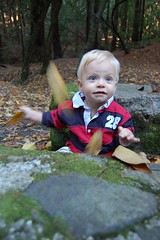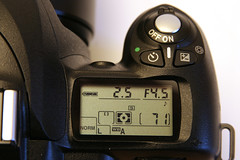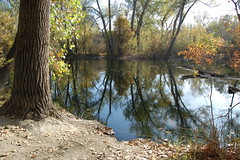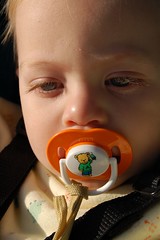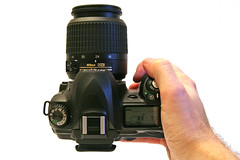Nikon D50 GuidePosted in November 2005 (Revised May 2006) This Nikon D50 Guide will introduce you to Nikon's extremely popular entry-level camera. A lot of its popularity has to do with how well the camera handles color. If you compare digital SLR photos from different cameras side-by-side, you'll notice that not all cameras capture color in the same way. The software inside each camera reproduces color in subtly different but noticeable ways. Part of what makes the Nikon D50 so exceptional (and many other reviewers and users of the camera agree) is that the color that it captures is vibrant and pure. The camera is also very responsive — it turns on in an instant and the autofocus locks onto subjects even in dim lighting (a challenge for most autofocus systems). |
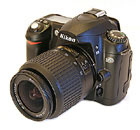 |
Quick Overview
- 6.0 megapixel sensor
- Compatible with Nikkor F-mount and D-type lenses
- 2.5 photos per second
- ISO settings from 200 to 1600
- Maximum shutter speed of 1/4000 of a second
- 1.5 times crop factor
- 2.0" LCD
- Stores photos on SD memory cards
- 5-area autofocus system
Key Feature
The key feature of the Nikon D50 is a fairly subtle one.
Professional photographers have a technique to really make photos pop: they use the camera's flash in broad daylight.
This is called "fill flash", since it fills in shadows created by the sunlight and creates more pleasing images.
Fill flash is most often used when taking portraits, but can be leveraged to add a touch of light to foliage and flower shots as well.
Let's say that you're taking photos of your child playing in the backyard, and want to reduce the intensity of shadows using fill flash. You don't want a lot of blurry photos so you need to use a fast shutter speed.
Here's where you run into a limit with digital SLRs: the flash synch speed.
The flash synch speed is the maximum shutter speed you can use when the flash is active.
On many other digital SLR cameras, the maximum flash synch speed is 1/250th of a second.
On the Nikon D50 it is twice as fast: 1/500th of a second.
This incredibly high flash synch speed is the small yet defining feature of the D50, and exceptionally useful if you see yourself taking a lot of photos with fill flash.
Who The Nikon D50 is For
While the Nikon D50 will suit a variety of photographers quite well, this is the ideal camera for parents.
Here's why:
- A special child portrait mode enhances skin tones
- Fast flash synch speed (see above)
- Lightweight and easy to carry around
- Instant turn-on time and responsive autofocus system
Landscape photographers should also be quite happy with the way the D50 captures vibrant colors found in nature. If you're both a parent and a landscape enthusiast, then you're set!
In Comparison
In this section of the Nikon D50 Guide, I'll talk about how this camera differs from other similar models. Some differences might be a problem for you, and some may not bother you one bit.
No Depth of Field Preview
Here's a quick definition: depth of field is the amount in front of and behind the plane of focus that is also in focus.
For example, when you're using a wide angle lens and taking a landscape photo, you have a lot of depth of field: everything from foreground to background is in focus.
When you're taking a close-up of a flower, you have limited depth of field: the flower is in focus, but not much else.
Depth of field is affected by the aperture setting on your camera. An aperture of f/3.6 produces shallow depth of field, while f/22 is deep depth of field.
Many digital SLR cameras have a "depth of field preview". This button adjusts the lens to the aperture setting you have selected on your camera.
It is particularily useful for macro (or close-up) photographers, because you are working with limited depth of field.
The depth of field preview button shows you exactly which parts of your photo are in focus and which parts are out.
To make this long story short, the Nikon D50 does not have a depth of field preview.
No Black and White Mode
If your passion is black and white photography, then the D50 isn't the right camera for you.
Many other digital SLRs like the Olympus E-330 and Canon 350D let you take photos in black and white.
The Nikon D50 does not have a black and white mode.
While it's easy enough to remove color from your photos using a software program, true black and white enthusiasts will want to consider other digital SLR cameras.
Limited ISO
I like to change ISO a lot to increase the light sensitivity of the camera's sensor.
So a minor gripe for this Nikon D50 guide is that this camera has a more limited ISO range than some other digital SLR models.
For example, the Minolta Maxxum's ISO range is from 100 to 3200, while the range on the Nikon D50 is 200 to 1600.
Again, this is not a huge issue, but if you take a lot of photos in dark locations (inside of buildings, for example), this camera is somewhat less flexible.
Reverse Metering Scale
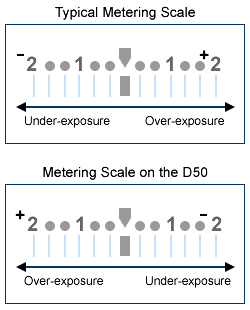
Many digital SLR cameras have a small scale in the viewfinder that tells you if the photo is properly exposed.
With manual control you can deliberately over-expose or under-expose depending upon the scene your photographing.
On every digital SLR I have ever used, the scale has minus on the left and plus on the right. Minus means under-exposed and plus means over-exposed.
This also makes sense from a math perspective, since all charts are set up such that reading left to right is low to high.
The scale on the Nikon is reversed, with minus on the right and plus on the left.
You won't be bothered by this if this is your first digital SLR or if you don't use the manual mode.
It did confuse me...you can guess why.
With the scale reversed, each time I thought I was under-exposing I was over-exposing and vice versa.
On The Other Hand...
Having just critiqued this camera, let me say this: these issues don't impact the impressive photos that you can take with the D50.
I thoroughly enjoyed using the D50, and have recommended to many as an ideal digital SLR to get started with.
The D50 has also won out over other cameras in my selections of best digital SLRs:
Head to Head
If you'd just like to see how the Nikon D50 stacks up against other specific camerra models, follow the links below.
How It Works
In Use
The shutter on the Nikon D50 is exceptionally quiet
This makes it the ideal camera for photographers who don't want to be noticed.
If you enjoy taking candid portraits or take a lot of photos inside museums where it's dead quiet, you don't want everyone to notice that you're snapping photos.
Nikon did a great job on reducing the noise made by the shutter on the D50.
You be the judge! Here are sample audio files of the shutter for the Nikon D50, the Canon EOS 350D and the Canon 20D.
Color
While I am not one to go on and on about the color on an LCD (remember, it doesn't match your monitor) I was really impressed with this camera's LCD.
I took several photos of a spectacular sunset (you can see them in the sample gallery below) and reviewing the shots on the LCD was almost better than the sunset itself!
Blues and reds were vibrant, which surprised me.
Most LCD screens tend to wash out colors because they are bright. The brightness is so that you can see them clearly in the middle of the day.
Even when I was using the Nikon D50 in bright sunlight, I could still see vibrant color after each shot.
Since I'm talking about color, let's move away from the LCD and talk about the actual photos that the Nikon D50 takes.
More than other digital SLR camera that I have used, the Nikon D50 really does bright colors justice.
Even in changing light conditions from bright sun to deep shade, the Nikon D50 makes colors pop.
For this Nikon D50 guide I took a lot of photos of my son. You can see those in the sample gallery at the bottom of this page.
I was pleased about how the camera handled his skin tone and especially the color of his eyes.
Size, Shape and Weight
Right out of the box, my immediate reaction was "this is cheap". The camera felt light and flimsy in my hand, almost like plastic.
I soon realized that I got this impression because I am biased.
I am used to carrying around cameras that weigh a ton, and when they don't I get the impression the camera is poorly made.
After a few days of use, I realized this was not the case with the Nikon D50.
The camera is made of a composite material instead of metal which explains the light weight. Despite this, the Nikon D50 is very solid and feels quite sturdy in the hand.
The grip is comfortable and large, which works well for anyone with larger hands.
Program Mode
How does the Nikon D50 work for every-day photography?
If you tend to use the program features on your digital camera (I have to admit that I rarely do) then the Nikon D50 is going to work great.
Some of the program features include landscape, portrait, macro and sports.
One that I found especially interesting was a program mode specifically for children. I haven't seen this program mode on a lot of other digital SLRs.
I used this mode to photograph my son and was impressed with the results - both in terms of detail and color.
In program mode, the camera is very easy to use.
The fact that it doesn't weigh a ton helps for those who want to take the camera on hikes and other excursions. You don't feel like you're hauling around a brick with the Nikon D50.
Lenses
The most common Nikon D50 kit comes with a Nikon ED AFS-DS Nikkor 18-55mm f/3.5-5.6 lens.
The lens works well for landscapes and is also just fine outdoors where there is plenty of ambient light.
It's not as good for indoor photography, because it doesn't let in enough light.
You can read more about maximum aperture to find out why this is the case.
The zoom range on the lens is limited, which means that you have to be right up close to your subject.
The most notable part of this lens is that it uses Nikon's ED glass, typically reserved for much more expensive top-of-the-line lenses.
ED stands for Extra-low Dispersion, and it is designed to reduce chromatic aberration.
For anyone not well-versed in the refraction index of light, it means't that you're getting a lens with high-quality optics for a very reasonable price.
Additional Lenses
Maybe the kit lens isn't right for you, or you just want a second lens.
If you don't know lens jargon and aren't sure how to pick one, read the guide to digital SLR lenses first.
The 50mm lenses will let in a ton of light, and are great alternatives to the kit lens if you take a lot of photos in low light and don't need a zoom.
The ulra-zooms are good for people who don't want to spend a ton of money on lenses, but still want a wide zoom range to work with when taking photos.
The telephoto lenses are for more professional use, which you can easily tell by the price.
| TYPE | MAKER | LENS | PRICE |
| Wide Angle Zoom | Sigma | 12-24mm f/4.5-5.6 | $ 600.00 |
| Wide Angle Zoom | Sigma | 15-30mm f/3.5-4.5 | $ 500.00 |
| Low Light | Nikon | 50mm f/1.8D | $ 110.00 |
| Low Light | Nikon | 50mm f/1.4D | $ 270.00 |
| Ultra Zoom | Nikon | 18-200mm f/3.5-5.6 ED AF-S VR DX | $ 800.00 |
| Ultra Zoom | Nikon | 80-400mm f/4.5-5.6D ED | $ 1,430.00 |
| Ultra Zoom | Tamron | 28-300mm f/3.5-6.3 XR Di LD | $ 365.00 |
| Telephoto Prime | Nikon | 400mm f/2.8D AF-S II | $ 7,700.00 |
| Telephoto Zoom | Nikon | 70-200mm f/2.8G ED-IF AF-S VR | $ 1,600.00 |
The Pros and Cons
| Pros | Cons |
|
|
Nikon D50 Photo Samples
This is just a small selection of sample photos taken with the Nikon D50. To see a wider variety of shots, check out the complete Nikon D50 Photo Gallery.
 |
 |
 |
 |
 |
 |
 |
Price Analysis
The Nikon D50 is one of the cheapest digital SLRs you can buy.
Here's the price comparison:
| MAKER | CAMERA | PRICE |
| Pentax | *ist DL with 18-55mm Lens | $ 533.00 |
| Nikon | D50 with 18-55mm lens | $ 650.00 |
| Olympus | E500 with 14-45mm lens | $ 710.00 |
| Canon | EOS 350D with 18-55mm lens | $ 780.00 |
Accessories
Once you've got a great Nikon D50 camera, it's time to accessorize it!
Most accessories for the D50 are optional, but some will make your life considerably easier.
Batteries
The Nikon D50 uses a rechargeable EN-EL3e battery pack.
While the battery provides power to the camera for quite a bit of time, I always recommend an extra battery for those times when you forget to recharge.
For an extra $50, it's not a bad insurance policy.
Memory Cards
The Nikon D50 uses the small-sized SD cards to store photos.
With 6.1 megapixels, you're going to want at least a 512MB card, although you can also double that capacity to 1GB.
I do recommend the high-speed cards, since these improve the rate the camera can save photos the card, and makes it faster to transfer photos to your computer.
| CARD | SIZE | PRICE |
| SanDisk | 512 MB | $ 39.00 |
| Panasonic | 512 MB | $ 25.00 |
| SanDisk | 1 GB (1024 MB) | $ 53.00 |
| Lexar | 1 GB | $ 73.00 |
For Owners
Manuals
Not sure about a feature on the Nikon D50 and want to check the user manual? Here you go:
Digital SLR Lessons
Tired of missing great photo opportunities even though you have an advanced digital SLR camera?
I'll let you in on a little secret: there's nothing wrong with your camera.
Digital SLRs are great at taking photos, but not so good at making decisions - it's up to you to know what you want and to take manual control when you have to.
Here's some good news: it's easier to learn how to use your digital SLR than you might think.
In fact, you can learn all about all the features of your Nikon D50 digital SLR camera in just 5 easy online lessons.
Reference Books
| United States | United Kingdom | ||
| Digital SLR Home | Other Camera Guides |
